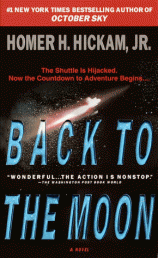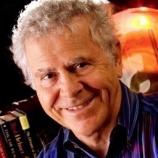Back to the Moon
Review
Back to the Moon
The sky is the limit for author/scientist Homer Hickam --- a man who is accustomed to having his dreams come true. ROCKET BOYS, his memoir about his ambition to become a NASA engineer became a critically acclaimed best seller and was made into the film, October Sky. Just in time to celebrate America's 30th anniversary of the first manned landing on the Moon, Hickam has written a fictional account called BACK TO THE MOON. Not bad for a boy who grew up in a small West Virginia coal town where a young man's only hope of escape was through a football scholarship.
But wait, Homer Hickam has another dream. He wants America to go back to the moon. He contends that rare minerals found during the 1970s moon walks may be a solution to cold fusion, future fuel shortages and other space age advancements for our country. Not content with merely writing feature editorials on the subject in The Wall Street Journal and scientific journals, Hickam has applied his considerable story telling skills to a rollicking fictional account of a frustrated, ex-NASA scientist who hijacks a Columbia Space Shuttle, retrofits it in space and heads BACK TO THE MOON.
Jack Medaris, an entrepreneurial space engineer with a shaky past works for a private research group which is perfecting a cold fusion generator called Project Prometheus. This invention by a Montana scientist holds the promise of solving Earth's fuel shortages forever. All that is needed to complete the project is a small amount of Helium-3, nearly impossible to find on earth, but abundant on the Moon.
The story takes place only a few years in the future at a time when America's Space Shuttle program is being put out to pasture. What is slated to be Columbia's final mission turns into a hell-bent chase through the heavens as Washington, oil tycoons and corporate competitors try to figure out what the hijackers are up to, and once they find out, how to stop them.
Hickam's story is based on events that could actually occur --- from the retro-fitting of a shuttle into a moon orbit rocket, to the science behind the rare mineral, Helium-3, discovered by Astronaut Eugene Cernan on the last moon walk in 1972. Hickam's expertise in space technology and knowledge about continuing research in nuclear fission, antimatter annihilation and fusion lends an air of authenticity to this space adventure.
Hickam spent 18 years at NASA where his duties included directing and training payload specialist teams, extravehicular activities (EVAs) for repairing the Hubble Space Telescope repair missions and work on Spacelab-J, the first joint Japanese-American human spaceflight mission. Coupled with his proven storytelling skills, BACK TO THE MOON offers readers the space joyride of their lives as they join Jack Medaris and Janet High Eagle and crew in this thriller. Medaris's drive in an abandoned lunar lander across the lunar landscape could not be more convincing if Hickam, himself, had made the trip.
Perhaps Jack Medaris is an extension of Hickam. In a recent editorial in the Wall Street Journal he calls NASA "a zero-gravity version of Amtrak." He urges Congress and NASA to retire the aging, costly shuttle fleet and lay out a 10-year program to produce a working advanced propulsion space drive based on fission, fusion or antimatter physics.
"If, in a decade," Hickam writes, "we can get our first advanced propulsion drive, however small, booming around in space, I believe there will be no holding Americans back from truly conquering this enormously rich frontier. This Rocket Boy says, 'Let's Go!'"
Will Hickam succeed in lighting an imaginative rocket of interest under a lethargic nation? If his track record for fulfilling his dreams holds, look out, Moon --- here we come.
Reviewed by Roz Shea on April 11, 2000
Back to the Moon
- Publication Date: April 11, 2000
- Genres: Fiction, Science Fiction
- Mass Market Paperback: 512 pages
- Publisher: Island Books
- ISBN-10: 0440235383
- ISBN-13: 9780440235385





